Interpretations - Mystical Places - The Nazca Lines

The
Nazca Lines
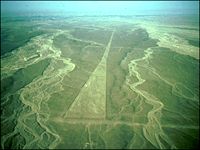
Runway
for alien spaceships? That's just one of the fanciful
theories on the purpose of the Nazca lines.
In the hot hazy desert of southwest Peru, couched between the Andes
Mountains and the Peruvian coast, lies what many have called one
of the most baffling enigmas of archeology. Huge geometric patterns
and spirals, animal figures including a monkey, a spider and an
'owl man', and thousands of perfectly straight lines are immaculately
etched onto the desert's surface. The last of them were drawn about
a thousand years ago. Known as the Nazca lines, the drawings have
mystified scientists since they were first discovered in the 1920s.
From ground level, the earth drawings, or geoglyphs as they're called,
seem like a confused mass of lines. It's only when viewed from
the air, that one sees how the lines and figures convey a sense
of purpose, of organization. But for whom? Why? And how did they
get such large drawings - one of the lines is 65 kilometres long,
and some of the animal drawings are more than two soccer fields
long - so precise?
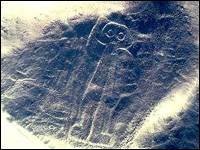
Phylliss Pitluga is a senior astronomer
at the Chicago Adler Planetarium. She's
studied the lines for more than ten years
- from an astronomical perspective. The
lines first captivated her when she saw
them from above in an airplane.
"When I got over there and flew over the site, I saw a sense of organization
that doesn't show up in small close-up photos," says Pitluga. "I
was fascinated and I was compelled to want to know more."
She's not the only one. Ever since the founder of Peruvian archeology,
Julio Tello, first recorded the lines in 1926, scientists have
spent years puzzling over the riddle of the Nazca lines. Still,
not one clear theory exists today that answers these basic questions,
making the drawings one of the world's most intriguing unsolved
mysteries.
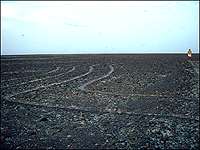
Thousands
of lines, hundreds of patterns
Scattered
over about 500 square kilometres of an arid plateau between
two river valleys around the city of Nazca, perhaps the
most famous of the drawings are the biomorphic figures:
a spider, a monkey, a whale, a snake, a lizard, a flower,
a man and 18 bird shapes, including the hummingbird and
the condor. There are about 50 of these figures ranging
in size from 25 metres to 275 metres long. Despite their
fame, these are confined to a small corner of the desert
- or the pampa, as it is called by the Peruvians.
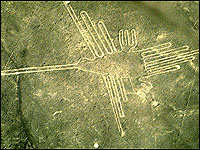
The
Hummingbird
Most
of the pampa is dominated by 1,300 kilometres of perfectly
straight lines, some as narrow as 6 inches and others
as wide as hundreds of metres, crisscrossing or running
parallel to each other. There are also 300 geometric
figures, mostly trapezoids, triangles, zig-zags and spirals.
The
Nazcans
The
Nazca lines are thought to have been made by the Nazca
Indians who lived in the region between 300 BC and 800
AD. Their pottery has been found at the Nazca lines.
Predecessors of the Incas, the Nazca Indians didn't leave
any evidence of a written language, and none of their
descendants survive today.
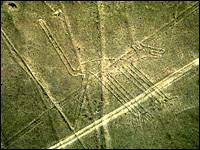
But
we do know that they were farmers, says Persis B. Clarkson,
an archeologist and expert in geoglyphs at the University
of Winnipeg. Although the region is one of the driest
in the world, the land is fertile, and the Nazcans made
use of a subterranean irrigation system to water their
crops. They made channels and tunnels to access the water
system, which would have required a way to regulate the
water system, says Clarkson. And that implies that Nazcan
society was a hierarchical one.
They also worshipped deities. Some of the pictures on their pottery
are of figures with both animal and human characteristics - and
some very scary features, says Clarkson. Exaggerated eyes and large
fangs on their half-feline, half-human creatures, for example,
suggest "that there was a greater power out there than humans."
Their huge burial sites also show that they paid special attention
to their dead, placing them in their graves in the fetal position,
wrapped with beautiful cloths.
return to top >

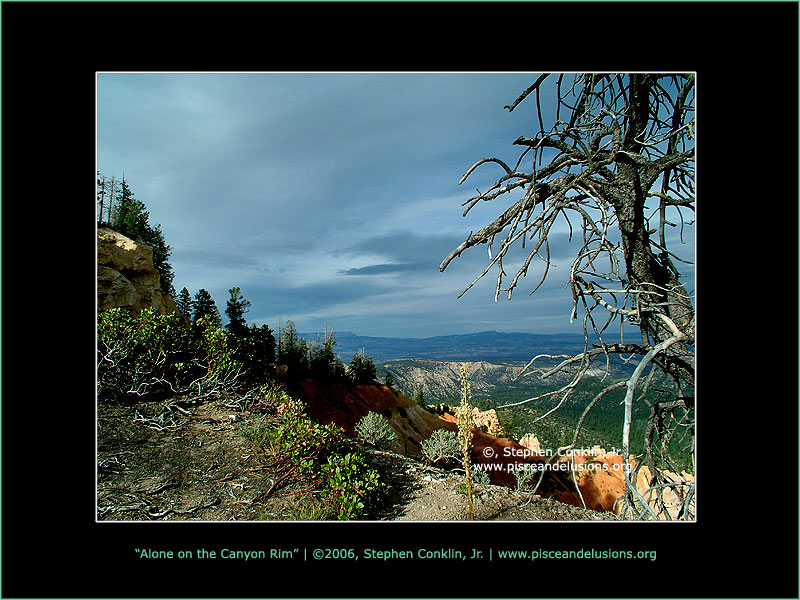
"Alone on the Canyon Rim" | ©2006, Stephen Conklin, Jr.
view larger size | order online

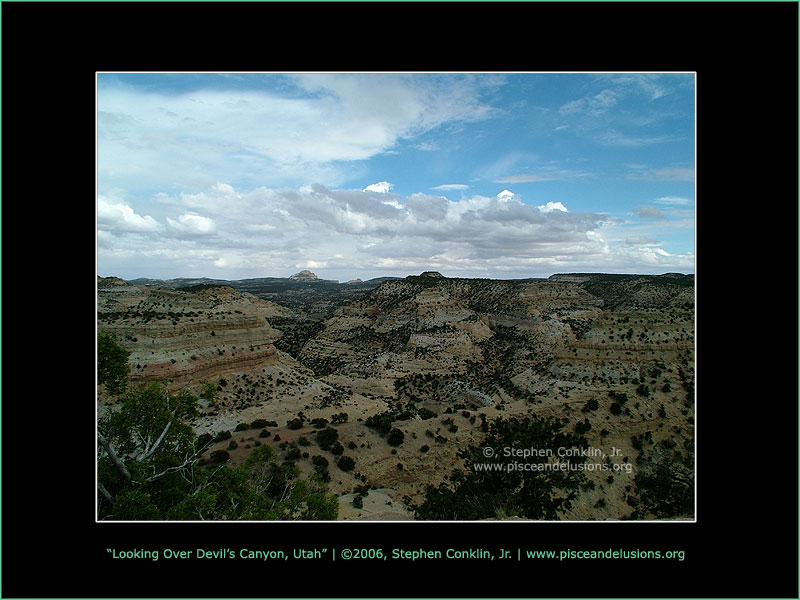
"Looking Over Devil's Canyon, Utah" | ©2006, Stephen Conklin, Jr.
view larger size | order online

return to top >
|









